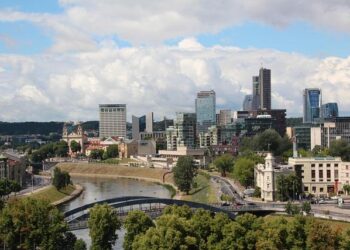Lithuanian authorities have assured the public that there is no radiation risk to the country in the event of an accident at Ukraine’s Zaporizhzhia nuclear power plant, according to a statement released by the national broadcaster LRT. The reassurance comes amid ongoing concerns about the safety of the facility, which has been at the center of heightened tensions due to the conflict in the region. Officials emphasized that monitoring systems are in place and that contingency measures have been evaluated to protect neighboring countries.
Lithuania Assesses Potential Impact of Zaporizhzhia Nuclear Plant Incident on Regional Safety
The Lithuanian authorities have conducted thorough evaluations following recent concerns about the safety of the Zaporizhzhia nuclear power plant. According to the State Nuclear Power Safety Inspectorate (VATESI), in the unlikely event of an accident at the facility, the immediate risk of radioactive exposure to Lithuania remains negligible. Officials emphasize continuous monitoring protocols and close collaboration with international nuclear safety organizations to ensure early detection and rapid response should any irregularities arise.
Key measures highlighted by Lithuanian experts include:
- Stringent air quality and radiation level surveillance across border regions.
- Regular updates from the International Atomic Energy Agency (IAEA) on plant status.
- Preparedness drills coordinated with neighboring countries to streamline emergency responses.
| Monitoring Parameter | Status | Frequency |
|---|---|---|
| Radiation Levels | Stable | Hourly |
| Airborne Particulates | Within Safe Limits | Daily |
| Plant Radiation Emissions | No Anomalies | Weekly |
Experts Emphasize Monitoring and Emergency Preparedness in Response to Nuclear Risks
Authorities and nuclear safety experts have reiterated the importance of vigilant monitoring and well-coordinated emergency preparedness strategies in light of potential risks associated with the Zaporizhzhia nuclear plant. While Lithuanian officials currently assert that there is no radiation threat to their population, experts stress that continuous assessment, real-time data collection, and rapid response plans remain essential to mitigate any unforeseen incidents. This proactive approach includes cooperation among neighboring countries and international regulatory bodies to ensure transparency and prompt communication.
Key components highlighted by specialists for effective nuclear risk management include:
- Comprehensive radiation monitoring networks around sensitive areas and along likely wind and water paths
- Regular emergency drills involving public authorities, medical teams, and civil defense units
- Public information campaigns to educate citizens on safety measures and evacuation procedures
- Robust communication channels for timely alerts and instructions
| Preparedness Measure | Purpose | Status |
|---|---|---|
| Radiation Monitoring | Continuous data collection & early detection | Active |
| Emergency Drills | Test readiness and response coordination | Biannual |
| Public Education | Inform citizens about safety protocols | Ongoing |
| Intergovernmental Cooperation | Enhance communication and joint response | Established |
Authorities Urge Public Confidence Amid Reassurances on Radiation Exposure Levels
Authorities in Lithuania have emphasized that there is no immediate risk of radiation exposure to the public following concerns around the situation at the Zaporizhzhia nuclear power plant. Experts monitoring the plant’s status have repeatedly confirmed that radiation levels remain within safe limits, reassuring citizens that everyday activities do not pose health threats. In addition, continuous surveillance protocols are being maintained to promptly detect any changes.
Officials have outlined several key points to bolster public confidence:
- Regular air and water quality testing near residential areas
- Ongoing communication between national and international nuclear safety agencies
- Emergency preparedness plans are fully updated and tested
- Access to real-time radiation monitoring data for transparency
| Parameter | Current Level | Safety Limit |
|---|---|---|
| Airborne Radiation (őľSv/h) | 0.07 | 0.25 |
| Water Radioactivity (Bq/L) | 0.15 | 1.0 |
| Soil Contamination (Bq/kg) | 12 | 50 |
To Conclude
As investigations and monitoring continue, Lithuanian authorities remain vigilant but assure the public that there is currently no radiation risk stemming from the Zaporizhzhia nuclear plant. Officials emphasize ongoing cooperation with international agencies to ensure safety and transparency in the region. The situation will be closely followed in the coming days to provide timely updates.
















